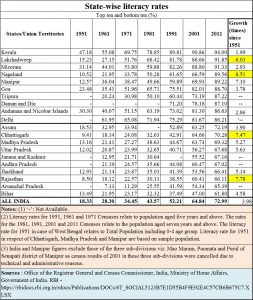http://www.freepressjournal.in/analysis/need-to-take-literacy-improvement-seriously-r-n-bhaskar/1282452
Very few states take literacy improvement seriously
— By | May 24, 2018
The government of India like to crow about how it has improved India’s literacy levels ever since independence. But when the numbers are studied carefully for a long period of time, the performance isn’t worth a mention.
 India claims that its literacy levels stand at around 72.99% according to the latest Census and figures released by the Reserve Bank of India (RBI) in its latest Handbook of Statistics on Indian States – see table. But there are three indicators that debunk such findings.
India claims that its literacy levels stand at around 72.99% according to the latest Census and figures released by the Reserve Bank of India (RBI) in its latest Handbook of Statistics on Indian States – see table. But there are three indicators that debunk such findings.
A word of caution is required here – the poor performance certificate does not apply merely to the present government in power. It applies to all governments, particularly the Congress which has ben at the helm of affairs for the longest period of time.
Take the first reason. In India, thanks to a very clever bureaucratic interpretation, abetted slyly by the political class – literacy has been defined as capability of reading and writing one’s name in any language. Thus if a boy is named Ram and he can read and write and pronounce just the three letters that make up his name, he would be described as being literate, even if he does not know the other alphabets. This was a very clever way of fudging data to conceal the actual state of illiteracy in India (http://www.asiaconverge.com/2016/12/fudging-education-data-produces-sludge/). India is quite adept at fudging data. Other countries have a higher benchmark for determining literacy – either all the alphabets, or high school, preferably both. If the higher norms were taken into account, it is likely that India would sport a literacy level of half the stated number.
Second, one would expect the literacy levels to have gone up at least seven times in seven decades. When literacy levels are low, one expects the growth rates to be extremely high. Yet, over the past 60 years, India’s literacy levels have gone up only four times. If one considers the cut-off level at six times, only five states fit the bill – Lakshwadeep, Nagaland, Manipur, Chhatisgarh and Jharkhand. Ignore states like Kerala and Mizoram, which have always had a passion for literacy.
Significantly, the most industrialised state, Maharashtra, does not even figure among the top 10 (it stands #14). Its literacy growth was just around 3 times since 1951 (from 28% in 1951 to 82% in 2011). If one goes purely by anecdotal evidence, it political class is more interested in making money from (sub-standard) medical and engineering colleges. Sadly, it is the first state to even pass a law allowing homeopaths and practitioners of traditional medicines become allopaths by just passing a bridge course. Suggestion: May we recommend to the chief minister that all IPS and IAS officers could be upgraded from government clerks by just passing a bridge course?
There is a third reason. Take the latest ASER 2017 (Annual Status of Education Report brought out by NGO Pratham) report (http://img.asercentre.org/docs/Publications/ASER%20Reports/ASER%202017/aser2017nationalfindings.pdf). It points to “the current status of foundational skills”. They reveal that almost 25% of the age-group 14-18 years cannot read basic text fluently in their own language. More than half of them struggle with simple division (3 digit by one digit). Only 43% can do such sums correctly. This appears to buttress reports from both McKinsey and Nassom that only 25% of the applicants are employable (http://www.asiaconverge.com/2018/05/governments-jobs-problem-serious-solutions-hand/).
Take the three together, and even the most charitable estimates of India’s literacy level should not be more than 35%.
There are two solutions to redress this malaise.
- Immediately introduce globally acceptable norms to determine literacy. Economic planners do not see a problem till it stares at them in the face.
- Immediately de-licence primary and secondary school education. Remove tax exemptions for private medical, engineering and management colleges till students qualify at a national outcome performance appraisal test. Apply such outcome evaluation systems for schools as well. Introduce the proviso that if the outcomes do not exceed clearly defined benchmarks, the management of errant schools (along with land, building and students) would be handed over to another management which has met such outcome norms. That will compel managements to be serious about the quality of teaching and the performance of students.
But that would require politicians to be concerned about public welfare, isn’t it?





































COMMENTS